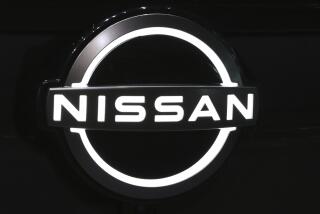Air Bag Injuries Less Likely in Newer Cars
- Share via
WASHINGTON — The National Highway Traffic Safety Administration said Tuesday that air bags installed in cars since 1997 have become safer and are causing fewer fatalities.
The agency, in reviewing a decade’s worth of data that it requested from automakers and from its own test results, said a combination of technical changes in air bags over the past few years and behavioral changes on the part of drivers and passengers have made riding behind an air bag safer in newer-model cars and trucks.
“It’s not just the technology that is getting better, but we’re influencing behavior,” said a top NHTSA official who conducted a briefing on the issue.
NHTSA officials, who asked not to be named, credited parents for belting children into the rear seats of vehicles--as well as increased seat belt use and smaller drivers sitting farther back from the air bag--for the decline in fatalities. To date, 83 children and six adults have been killed by air bags on the passenger side. The NHTSA said there have been 56 fatal air bag accidents on the driver side.
But the biggest change occurred in 1997 when the government--alarmed at the increasing number of deaths of women and children from overly aggressive air bags--told automakers they could “depower” air bags so that they inflate with less force. At the same time, the NHTSA allowed manufacturers to abandon a crash test into a fixed barrier and to use a less stringent test to meet its safety standard to hasten redesign.
What the agency is trying to determine is how much protection less aggressive air bags offer to women and children in lower-speed accidents--particularly when they are not properly seated in the vehicle--and whether depowered air bags compromise safety for larger male drivers in higher-speed crashes.
These are key questions, because the agency is in the middle of revising its safety standard for the next generation of advanced air bags and automakers have been lobbying heavily not to return to the barrier test. The barrier test requires crashing unbelted dummies at 30 mph, a speed that automakers say will result in the return to an air bag that poses danger to women and children.
“The test speed should be reduced to 25 mph. That will allow depowered bags to continue. We don’t want to have to redesign air bags to be more powerful,” said Vann Wibur, director of vehicle safety for the Alliance of Automobile Manufacturers, whose members are 11 domestic and foreign automakers. “We’ve seen no evidence these depowered bags are insufficient in the crashes we’ve investigated so far.”
Consumer groups, however, are concerned that abandoning the 30-mph test will result in an air bag that will not provide enough protection for unbelted male drivers who are depending completely on the air bag for protection.
The NHTSA seems to share that concern. The agency conducted tests to determine how depowered bags would perform in higher-speed crashes. The results showed that, with few exceptions, carmakers could pass the more demanding 30-mph test using the new depowered air bags, the agency said.
Only the 1999 Honda Acura RL slightly exceeded the average injury limit set by NHTSA for leg injuries. On the passenger side, the 1998 Dodge Neon exceeded average injury limits set by the NHTSA for forces on the chest during a crash. Both cars, however, comply with the safety standard that currently is in existence and are safe, the agency said.






